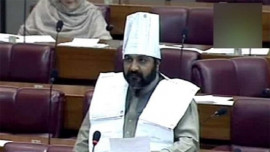
“In order to implement a load-shedding schedule, the government has divided electricity consumers into two categories,” said a senior government official.
Making progress: Delayed projects being completed swiftly: WAPDA chief
In the first category, the jurisdictions served by electricity feeders that have less than 10% transmission and distribution losses will face no load-shedding. These feeders serve 14.92 million or 60.72% consumers across the country.
In the second category, the feeders, where losses are estimated in the range of 10% to 20% and which serve 21.7% of consumers, the duration of load-shedding will be two to four hours in the summer season of the current year.
The government official revealed that the National Power Control Centre (NPCC) and power distribution companies had expected that average growth in consumer demand would range from 10% to 13% in 2018 compared with the average demand in 2017.
He said the level of shortfall would vary from 5% to 7% from March to October 2018.
During peak hours, the government has planned to cope with the shortfall by utilising water in dams in a bid to generate more hydroelectric power to meet the high demand.
Year 2017 had proved more difficult than expected on the back of high temperature, a record shortfall in hydroelectric power generation and delay in the start of three liquefied natural gas (LNG)-based power plants in Punjab, Neelum-Jhelum power project and Tarbela fourth extension project.
PTI lawmaker adopts unique way of protesting against electricity bills
Both average and peak demand scenarios and expectations for power production for the March-October 2018 period have been portrayed keeping in view the demand and supply of electricity in 2017.
The supply assumptions are based on five-year data of hydroelectric power generation and scheduled closure of power plants for maintenance. The assumptions do not include expected power generation from new units of the Neelum-Jhelum plant and the Tarbela fourth extension project.
Quoting estimates, the government official disclosed that the three LNG-based power plants would produce nothing in March 2018, but they would generate 2,242 megawatts in April and 3,000MW from May onwards.
New hydroelectric power projects will add 1,444MW to the national grid in April and 1,410MW in August.
The government official, however, boasted that the government had been able to address serious challenges pertaining to electricity generation, adding its focus should now turn to improving governance of power distribution companies.
“The government will take all possible steps to ensure uninterrupted electricity supply during Sehr and Iftaar in Ramazan. For this purpose, the distribution companies will have sufficient supply from back-up transformers as their breakdown was a major cause of load-shedding earlier,” he said.
Published in The Express Tribune, March 16th, 2018.
Like Business on Facebook, follow @TribuneBiz on Twitter to stay informed and join in the conversation.











































COMMENTS
Comments are moderated and generally will be posted if they are on-topic and not abusive.
For more information, please see our Comments FAQ